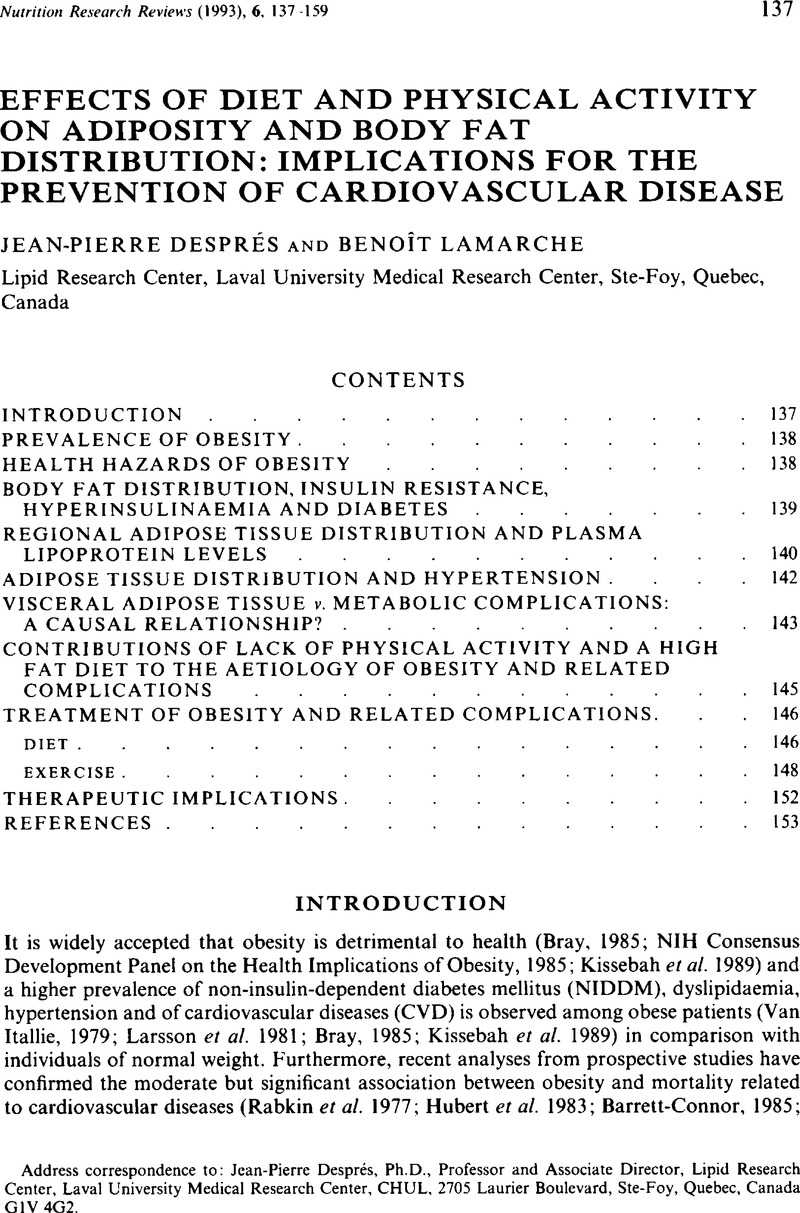Crossref Citations
This article has been cited by the following publications. This list is generated based on data provided by Crossref.
Després, Jean-Pierre
1994.
7 Dyslipidaemia and obesity.
Baillière's Clinical Endocrinology and Metabolism,
Vol. 8,
Issue. 3,
p.
629.
Ashwell, Margaret
1994.
The fruit bowl approach to the treatment of obesity.
Nutrition Bulletin,
Vol. 19,
Issue. 3,
p.
170.
Ruiz-Gutiérrez, V.
and
Barron, L.J.R.
1995.
Methods for the analysis of triacylglycerols.
Journal of Chromatography B: Biomedical Sciences and Applications,
Vol. 671,
Issue. 1-2,
p.
133.
Stevenson, Edith T.
Davy, Kevin P.
and
Seals, Douglas R.
1995.
Hemostatic, Metabolic, and Androgenic Risk Factors for Coronary Heart Disease in Physically Active and Less Active Postmenopausal Women.
Arteriosclerosis, Thrombosis, and Vascular Biology,
Vol. 15,
Issue. 5,
p.
669.
Vohl, Marie-Claude
Lamarche, Benoı̂t
Moorjani, Sital
Prud’homme, Denis
Nadeau, André
Bouchard, Claude
Lupien, Paul-J.
and
Després, Jean-Pierre
1995.
The Lipoprotein Lipase
Hin
dIII Polymorphism Modulates Plasma Triglyceride Levels in Visceral Obesity
.
Arteriosclerosis, Thrombosis, and Vascular Biology,
Vol. 15,
Issue. 5,
p.
714.
Jungermann, K.
and
Barth, C. A.
1996.
Comprehensive Human Physiology.
p.
1425.
Lemieux, S
Prud’homme, D
Bouchard, C
Tremblay, A
and
Després, JP
1996.
A single threshold value of waist girth identifies normal-weight and overweight subjects with excess visceral adipose tissue.
The American Journal of Clinical Nutrition,
Vol. 64,
Issue. 5,
p.
685.
Williams, Christine M.
1997.
Cardiovascular risk factors in women.
Proceedings of the Nutrition Society,
Vol. 56,
Issue. 1B,
p.
383.
Williams, MJ
Hunter, GR
Kekes-Szabo, T
Snyder, S
and
Treuth, MS
1997.
Regional fat distribution in women and risk of cardiovascular disease.
The American Journal of Clinical Nutrition,
Vol. 65,
Issue. 3,
p.
855.
Björntorp, Per
1997.
Obesity.
The Lancet,
Vol. 350,
Issue. 9075,
p.
423.
Dufour, Darna L.
1997.
Nutrition, Activity, and Health in Children.
Annual Review of Anthropology,
Vol. 26,
Issue. 1,
p.
541.
Vohl, Marie-Claude
Lamarche, Benoı̂t
Bergeron, Jean
Moorjani, Sital
Prud'homme, Denis
Nadeau, André
Tremblay, Angelo
Lupien, Paul J
Bouchard, Claude
and
Després, Jean-Pierre
1997.
The MspI polymorphism of the apolipoprotein A-II gene as a modulator of the dyslipidemic state found in visceral obesity.
Atherosclerosis,
Vol. 128,
Issue. 2,
p.
183.
Pollock, Michael L.
Gaesser, Glenn A.
Butcher, Janus D.
Després, Jean-Pierre
Dishman, Rod K.
Franklin, Barry A.
and
Garber, Carol Ewing
1998.
ACSM Position Stand.
Medicine & Science in Sports & Exercise,
Vol. 30,
Issue. 6,
p.
975.
Pollock, Michael L.
Gaesser, Glenn A.
Butcher, Janus D.
Despr??s, Jean-Pierre
Dishman, Rod K.
Franklin, Barry A.
and
Garber, Carol Ewing
1998.
ACSM Position Stand: The Recommended Quantity and Quality of Exercise for Developing and Maintaining Cardiorespiratory and Muscular Fitness, and Flexibility in Healthy Adults.
Medicine & Science in Sports & Exercise,
Vol. 30,
Issue. 6,
p.
975.
PESCATELLO, LINDA S.
and
MURPHY, DONNA
1998.
Lower intensity physical activity is advantageous for fat distribution and blood glucose among viscerally obese older adults.
Medicine& Science in Sports & Exercise,
Vol. 30,
Issue. 9,
p.
1408.
PESCATELLO, LINDA S.
and
MURPHY, DONNA
1998.
Lower intensity physical activity is advantageous for fat distribution and blood glucose among viscerally obese older adults.
Medicine& Science in Sports & Exercise,
Vol. 30,
Issue. 9,
p.
1408.
Després, Jean‐Pierre
1998.
The Insulin Resistance—Dyslipidemic Syndrome of Visceral Obesity: Effect on Patients' Risk.
Obesity Research,
Vol. 6,
Issue. S1,
Després, Jean-Pierre
and
Marette, André
1999.
Insulin Resistance.
p.
51.
Gower, Barbara A.
1999.
Syndrome X in children: Influence of ethnicity and visceral fat.
American Journal of Human Biology,
Vol. 11,
Issue. 2,
p.
249.
Reid, R.
and
Hackett, A.F.
1999.
Changes in nutritional status in adults over Christmas 1998.
Journal of Human Nutrition and Dietetics,
Vol. 12,
Issue. 6,
p.
513.



